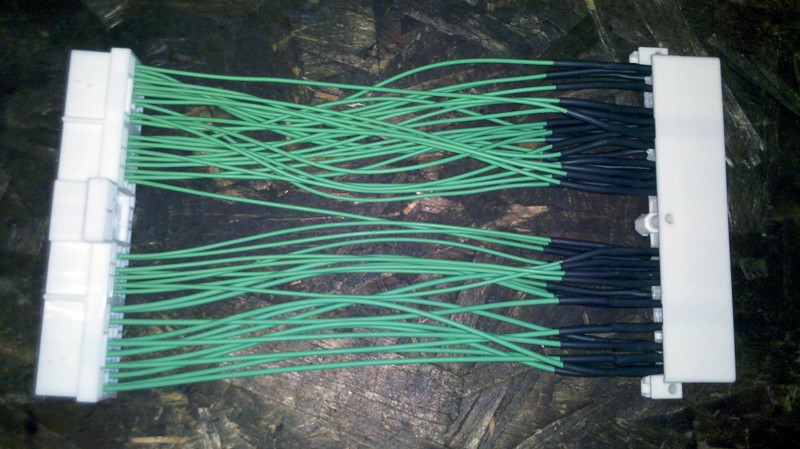Are you looking to enhance the performance of your older vehicle or perform an engine swap, and find yourself facing compatibility issues between your car’s On-Board Diagnostics (OBD) systems? Many enthusiasts and mechanics encounter this problem when working with engines and vehicles from different eras. The solution often lies in understanding and utilizing an OBD2 to OBD1 jumper harness.
This article, brought to you by techcarusa.com, your trusted source for automotive expertise, will delve into the world of OBD2 to OBD1 jumper harnesses. We’ll explore what they are, why you might need one, and what to look for in a quality harness.
What is an OBD2 to OBD1 Jumper Harness?
In the automotive world, technology evolves rapidly. One significant leap was the transition from OBD1 to OBD2 systems. OBD1, the earlier standard, was less standardized and varied significantly between manufacturers. OBD2, introduced in the mid-1990s and mandated in the USA for all cars sold from 1996 onwards, brought greater standardization and enhanced diagnostic capabilities.
An OBD2 to OBD1 jumper harness is essentially an adapter. It’s a specially designed wiring harness that bridges the gap between a vehicle equipped with an OBD2 system and an engine or Electronic Control Unit (ECU) designed for an OBD1 system. Think of it as a translator for your car’s electrical language, allowing older engine management systems to communicate with newer vehicle wiring.
Why Use an OBD2 to OBD1 Jumper Harness?
There are several key reasons why you might consider using an OBD2 to OBD1 jumper harness:
- Engine Swaps in Older Vehicles: If you’re installing an older, high-performance engine (designed for OBD1) into a newer car originally equipped with OBD2, a jumper harness is often essential. It allows you to use the older engine’s ECU in the newer vehicle without extensive and complex rewiring of the entire engine management system.
- Utilizing OBD1 ECUs for Tuning: Many older OBD1 ECUs are favored in the tuning community for their simpler architecture and ease of modification. For certain applications, particularly in performance and racing, tuners may prefer the capabilities of an OBD1 ECU. An OBD2 to OBD1 harness makes it possible to install these older ECUs in OBD2 vehicles.
- Cost-Effectiveness: In some cases, utilizing an OBD1 ECU with a jumper harness can be a more cost-effective solution than trying to adapt or replace an entire OBD2 engine management system. This can be particularly true when dealing with performance modifications where aftermarket OBD1 tuning solutions are readily available and potentially more affordable.
Key Features of a Quality OBD2 to OBD1 Jumper Harness
Not all jumper harnesses are created equal. When selecting an OBD2 to OBD1 conversion harness, quality is paramount for reliable performance and to avoid electrical issues. Here are some crucial features to look for:
- Brand New Connectors and Wiring: A high-quality harness will use brand new, OEM-grade connectors. This ensures a secure and reliable connection, minimizing the risk of poor contacts and electrical faults. Similarly, new, high-quality wiring is essential for longevity and proper signal transmission. Avoid harnesses that use salvaged or low-grade components.
- Proper Construction and Insulation: The harness should be professionally constructed with proper wire crimping, soldering (if applicable), and robust insulation. This protects the wiring from the harsh engine environment, including heat, vibration, and moisture.
- Vehicle and ECU Specific Design: Ensure the harness is specifically designed for your vehicle and the OBD1 ECU you intend to use. Compatibility is critical, and a correctly designed harness will guarantee proper pin-out and signal routing.
Compatibility and Installation
OBD2 to OBD1 jumper harnesses are typically designed for specific vehicle makes and models, and engine/ECU combinations. For example, you might find harnesses designed for Nissan SR20 engines in Nissan chassis that originally came with OBD2 systems.
Installation generally involves unplugging the factory OBD2 ECU connectors and plugging them into the OBD2 side of the jumper harness. Then, the OBD1 connectors on the harness plug directly into the OBD1 ECU. While often described as “plug and play,” it’s crucial to follow the manufacturer’s instructions carefully and ensure all connections are secure. In some cases, minor wiring adjustments might be necessary depending on the specific application.
Conclusion
The OBD2 to OBD1 jumper harness is a valuable tool for automotive enthusiasts and professionals alike. It simplifies engine swaps, unlocks tuning potential with older ECUs, and can offer a cost-effective solution for certain modifications. When choosing a harness, prioritize quality components and vehicle/ECU specific design to ensure reliable performance and seamless integration.
For more information on performance parts and engine management solutions, stay tuned to techcarusa.com, your ultimate resource for automotive knowledge and upgrades.

